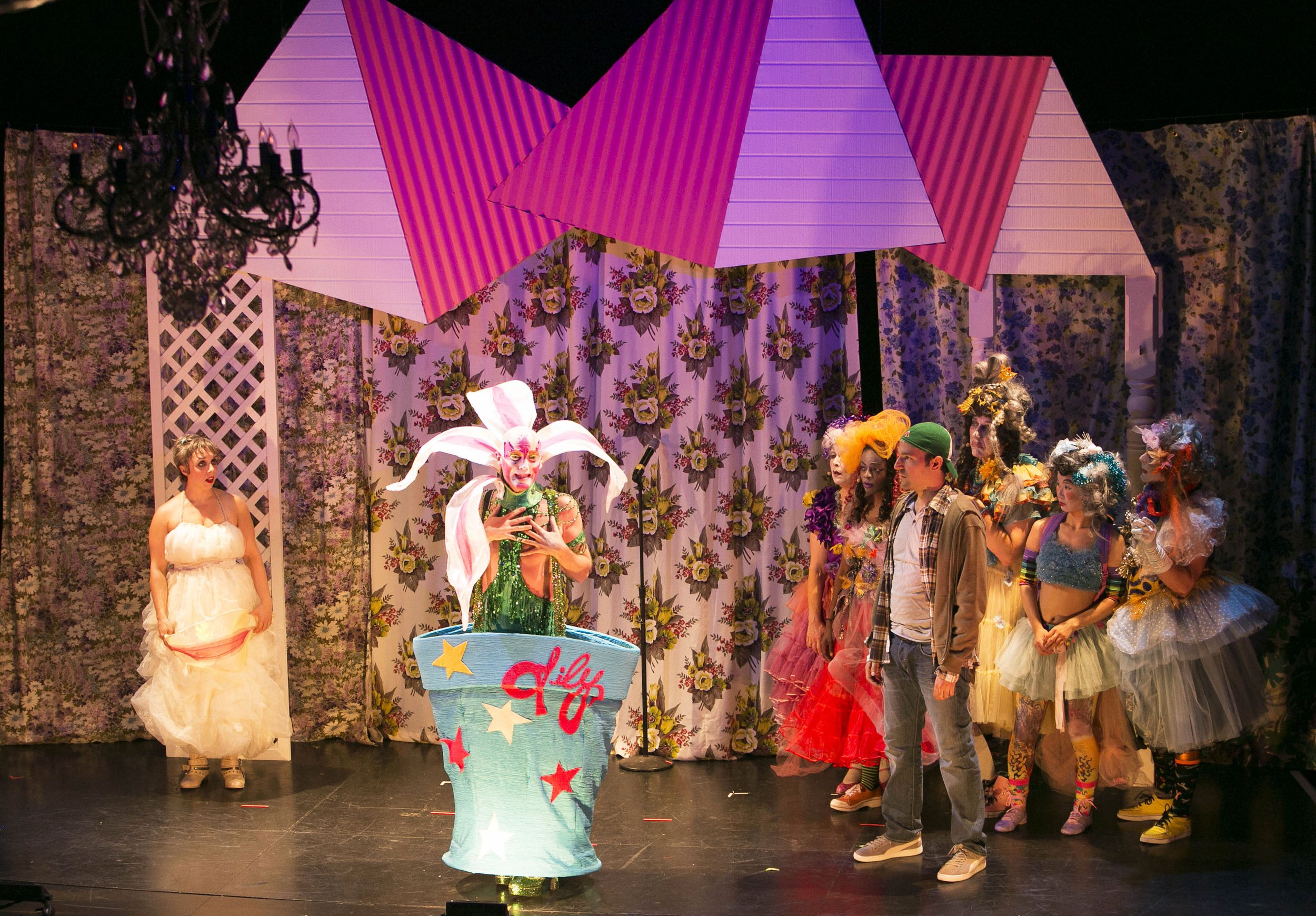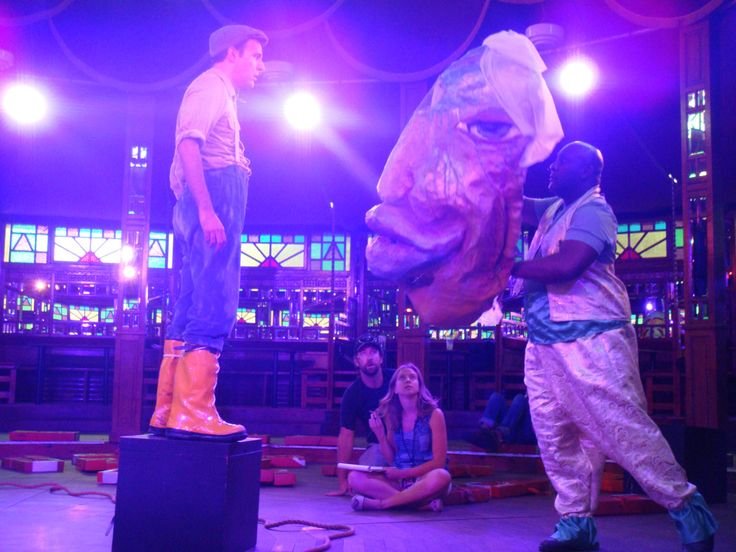Performing Arts Experience
It feels odd to talk about my “performing arts experience” as a separate category from my scholarly work, since after 2014 my academic work in Toronto so deeply intertwined itself with live performance-as-research into early plays — an approach which is rooted, for me, in my prior experiences with contemporary performance and theatre (usually in experimental, indie, or site-specific spaces). I’ll describe those prior experiences, here, in a roundabout, anecdotal way, which allows me to dwell in particular on those performances and training that laid down fundamentals for how I now understand, study, and produce early plays. What results is hardly a traditional “arts bio,” but it gets the job done:
A.R.T.’ s October 2012 The Lily’s Revenge — Bride Deity (Davina Cohen), the Lily (Taylor Mac), and Groom Deity (Matthew Milo Sergi) with bridesmaids.
Photo credit: Gretjen Helene.
My undergraduate training was in the BFA Drama program at the NYU-Tisch School of the Arts (1999-2003), with studio work at the Playwrights Horizons Theatre School (where I trained as an actor, designer, and director), followed by two semesters in Mary Overlie’s Viewpoints Intensive, and two in the Applied Theatre program (through which I completed a minor in Applied Theatre, winning 2003’s Community Connections award). While at Tisch, I also spent one summer studying at the Hangar Theatre Lab Company. At the Hangar, I was first introduced to the Viewpoints (but at that point only to the version that had been stolen from Overlie’s work, then hollowed out; the distinction between the two surviving versions has turned out to be crucial in understanding Overlie’s relevance to premodern performance); I was also picked up for a very small understudy role in the Hangar’s mainstage production of A Moon for the Misbegotten (dir. Norm Johnson, 2001) — in the one night I went on, I learned more about presence in live performance than in any acting class I’d ever taken. Still, I found I preferred to work on indie and experimental shows, usually in off-off-Broadway venues, including two plays at Access Theater (Machinal, as Husband, dir. Christina Baal; Enter Pissarro, as Pissarro, dir. Keith Powell) and two plays in the New York International Fringe Festival (in 2002 and 2003). I left New York for northern California in 2004 (when I was accepted into UC Berkeley’s PhD program in English).
While in northern California, I participated in a few site-specific performances in Davis (at the Davis Arboretum in Convivium, as the Innkeeper, dir. Ara Glenn- Johanson; at the UnCanny Festival in Seven Deadly Sins, as Lust/Pride, dir. Ashanti Newton), then spent the summer of 2008 studying with the San Francisco Mime Troupe’s Summer Workshop. My artistic collaborations with Ara Glenn-Johanson continued from there: I designed (and provided an original translation of the Old English Wanderer as the basis for) her 2009 contemporary dance piece, Earthstepper, which she toured in San Francisco and San Diego; in 2011, we co-created and performed in a short experimental piece, Decade/Case Study, which we premiered at TOO MUCH! A Queer Performance Marathon, hosted by THEOFFCENTER at Dance Mission, and then showed again at Kunst-Stoff. Ara and I also got married in 2009 (we met at NYU and have been together the whole way) — and the text of our wedding vows was converted into some of the song lyrics used in Erika Chong Shuch’s massive 2010 site-specific dance piece Love Everywhere (in which we both performed).
Ara and I also participated a few times in SQUART: Spontaneous Queer Art — an extemporaneous, ridiculous, pseudo-competitive gathering of local performance makers — which, looking back, I can now see both as emblematic of the best DIY work being done in SF, in those days, and as deeply formative for my performance-as-research into early English drama. Robert Avila’s 2011 piece in the San Francisco Bay Guardian describes what was going on in and around SQUART, including this bit:
All told, a moment from the last piece was probably my favorite. In a large first-floor room elegantly and eccentrically composed like something from a Peter Greenaway film, a good chunk of the audience had been pressed to the wall by a relentlessly advancing line of screaming men and women with their arms outstretched. Then a man rushed to the window and (with a vaguely camp bellicosity) ordered a small group of performers out the windows and up the hill. There in the cold drizzle they stood on the access road in shorts and tees, doing exercises, as two of the performers began to wrestle aggressively.
This “fight” inspired an unwitting passerby to come between them with real violence, as the audience gasped loudly in surprise and alarm at the unscheduled event. The good Samaritan, flushed and angry, cocked a confused glance at the audience of maybe 60 people filling the windows, and trudged back to his car and family and drove away, visibly shaken. The performance continued, in fact did not miss a beat, the performer at the window shouting a beautiful broken monologue full of yearning, confusion, and wonder interspersed with loud calls to “Retreat!” that sent the performers scrambling up the slippery hillside in the rain, bare limbs flailing, helpless, comical, and heartbreaking.
I was the man at the window. With Applied Theatre practices in mind, I had crafted the monologue from interviews I conducted with other participants over the course of the preceding twenty-four hours of that SQUART, at the Headlands Center for the Arts in March 2011 (during which I also celebrated my thirtieth birthday; I would complete my doctoral work at UC Berkeley that June).
Me with Harold Burns, involved a San Francisco performance piece of some kind (I can’t remember which one but I love the photo), c. 2011. Photo credit: Mark McBeth.
Meanwhile, with Randy Symank and Lauri Smith, Ara and I co-founded a small indie theatre company, Front Line Theatre (now disbanded), which produced two plays I had written. The first was Glory Glory, which I co-directed with Randy at the Fort Mason Center’s Northside Theatre in San Francisco in June 2010. Based on The Shewings of Julian of Norwich (Lauri played Julian) and The Book of Margery Kempe (Ara played Margery), Glory Glory was a recipient of Fort Mason’s In Performance Grant (sponsored by the Hewlett Foundation) and received a positive review from Sam Hurwitt at The Idiolect as “dizzyingly nonlinear,” “gleefully anachronistic,” and “often quite funny,” enough to “make you interested in the two women as characters and surprisingly involved in Margery’s story as it messily unfurls in all its self-contradictory glory” (click here to watch a teaser video of Glory Glory). The second was Rare Earth, a semi-devised play with dialogue entirely in Elizabethan-style verse, but set in a post-apocalyptic e-waste dump, which we developed during a performance residency at The Garage; we previewed it at the FURY Factory festival (at Noh Space) and then premiered it at San Francisco’s CounterPULSE in July 2011.
And then I got my first job as an English professor, at Wellesley College in Massachusetts, so Ara and I moved to the Boston area . In December 2011, at Cambridge’s Mobius performance space, we showed a short experimental piece called Waltz, a “one-person duet” in which I was the only person present (Ara was projected on video). Then, in July 2012, we returned to northern California briefly, to take up a month-long residency as Artists in Residence at the Headlands Center for the Arts — one of the program directors, having seen me in an October 2010 SQUART, had invited my application — where we expanded Decade/Case Study into an evening-length piece, Hyperthesis: Or, Overthinkers in Love (click here to watch a teaser video of Hyperthesis), featuring both of us as lovelorn academics, trapped in a web of words at a nightmarishly strange scholarly conference; we closed our residency, and said farewell to California, with a public workshop of that piece.
Rehearsal photo from The Magic Fish, summer 2013 — me, puppet designer Michael Kane, director Allegra Libonati, and the Fish, Calvin Braxton. Photo credit: Michael Kane.
Back in Boston, we were both cast by the American Repertory Theater in their October 2012 production of The Lily’s Revenge (dir. Shira Milikowsky), starring Taylor Mac. Lily’s was a massive, five-hour, five-act allegorical play about marriage equality and the wedding industry, with Mac as a talking humanoid lily who just wants to become a real man — and with me as “Groom Deity,” the “real man” who tries to bully the Lily away from the wedding. Working with Mac taught me most of what I know about camp; Lily’s (see the picture at the top of this page) was as close to a medieval morality play as any contemporary performance I’ve seen. After that, I played Dr. Zartosky in the Liars & Believers premiere of 28 Seeds (dir. Jason Slavick) at the Boston Center for the Arts — an experimental and very trippy musical conceived and written by Boston’s Walter Sickert & the Army of Broken Toys. In Boston in early 2013, I even acted in a feature-length film, as Birdo in Day of Youth (dir. Jared Vincenti). That April, I took on the title role in the Apollinaire Theatre production of Luther (dir. Danielle Fauteux Jacques), which Don Aucoin reviewed in the Boston Globe: “In Sergi’s fine portrayal, Luther is a childlike figure, projecting an air of innocence, curiosity, and bewilderment at the ways of the adult world that is at times reminiscent of James Stewart’s Elwood P. Dowd in ‘Harvey.’ But he also demonstrates unsettling signs of volatility. His movements are jerky, as if he’s trying to relearn how to be human.” Finally, right before we left Boston, Ara and I both performed (as the Fisherman and his Wife) in The Magic Fish (dir. Allegra Libonati), an all-ages show at the then-new Outside the Box Festival.
And so to Toronto, where I started working in September 2013, as an assistant professor in the Department of English at the University of Toronto. At the U of T, I was offered a position specifically in the study of early English drama, at a school (home to PLS) where live productions have long been recognized as a crucial form of research in that field — so, since then, most of my performing arts projects have also been performance-as-research projects, productions of Fulgens and Lucres (2014), Mankind (2015-16), and The Pride of Life (2016), described in detail elsewhere on this website (click here); in another combination of academia and performance, I created and co-ran the Scholars-in-Residence/Pre-Show Tea program at the Harbourfront Centre’s World Stage, in Toronto, from 2014 through 2017 (until the World Stage itself closed up shop). But Ara and I, who now call our collaboration team North America, have also continued to work on experimental, contemporary, devised performances in Toronto. In summer 2014, for instance, we performed together as part of the Toronto Fringe Festival in Ara’s contemporary performance piece, Now Keep in Mind That I’m an Artist (click here for a teaser video of that piece; yes, I’m the macaw). Then, in autumn 2014, we showed Hyperthesis: Or, Overthinkers in Love again, this time in a workshop production at Videofag. In 2015, our first daughter (of two) was born — so these days, I’m most often in charge of childcare during North America productions, a role I enjoy very much indeed.


